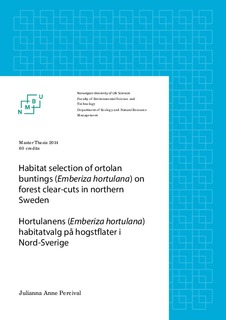| dc.description.abstract | The ortolan bunting (Emberiza hortulana) is one of the most severely declining
farmland birds in Europe. Since the 1970s, the population in Sweden has declined
more than 80%, and in Norway the population is close to extinction. While ortolan
buntings are traditionally linked to farmland, a large proportion of the remaining
population in Sweden is found on forest clear-cuts in northern Sweden. Few studies
have investigated habitat selection of ortolan buntings outside of farmland in Sweden,
and even fewer studies have identified the types of clear-cuts that ortolan buntings
prefer.
The main objective of this study was to identify specific habitat characteristics
influencing presence and abundance of ortolan buntings on forest clear-cuts in
Västerbotten County, northern Sweden. 123 clear-cuts were visited during the
breeding season (present N = 48, absent N = 75) and the results of the regression
models showed that clear-cut size, the number of remaining trees, bare soil percentage
(≥10%) and narrow-leaved grass vegetation had a positive influence on ortolan
bunting occupancy and abundance on clear-cuts. Further, vegetation litter and few
large rocks had a negative effect on the number of territories on clear-cuts. Although
larger clear-cuts had a higher probability of occupancy and a higher number of
territories, an additional linear regression showed that territory density (the average
number of territories per hectare) did not increase with clear-cut size.
In addition, proximity to farmland was not important, and combined with behavioural
observations in the field, this suggest that forest clear-cuts also provide suitable
foraging habitat. This contrasts with Norwegian clear-cuts occupied by ortolan
buntings, where breeding habitats are always found close to cultivated areas, which
are used for foraging. In Sweden, post-harvest conditions create a mosaic of
microhabitats and successional stages that provide suitable nesting sites and
apparently sufficient food supplies. However, it is important to keep in mind that
clear-cuts are transitional, short-lived habitats that develop into young forest within 5-
10 years. This thesis therefore offers some important insights on ortolan buntings
outside of farmland in Sweden, and based on this knowledge, appropriate
management policies can be implemented for the conservation of this species. | nb_NO |

